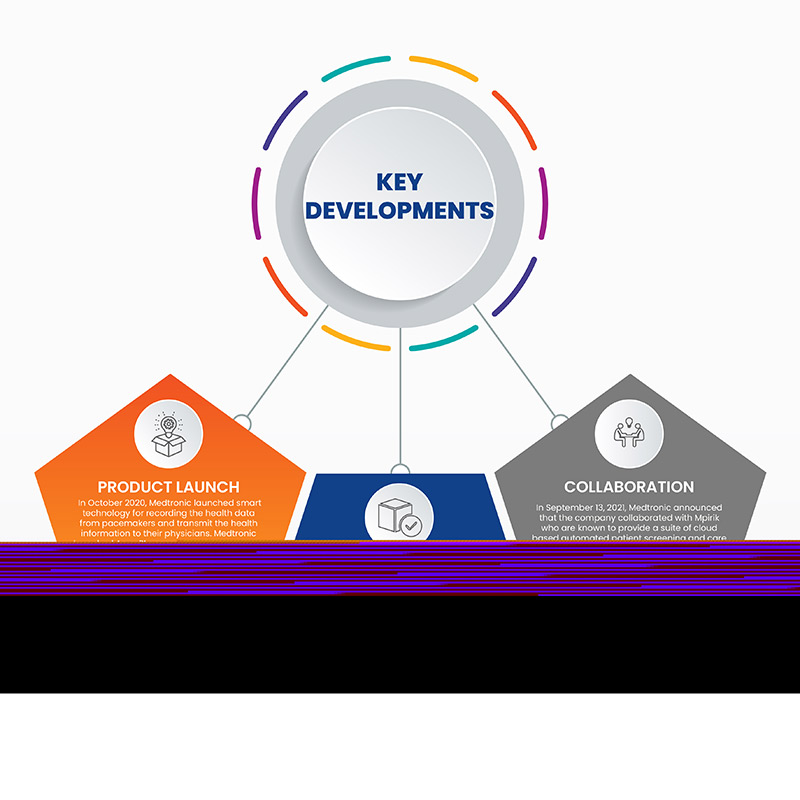Heart disease is the leading cause of death in both men and women, irrespective of ethnicity. In every 36 seconds, one person in U.S. dies of cardiovascular disease. Around 6,59,000 people die of heart disease every year in the U.S. itself. Heart attack and coronary artery disease are the two common and most prevalent cardiovascular diseases.
Access Full Report @ https://www.databridgemarketresearch.com/zh/reports/global-interventional-cardiology-peripheral-vascular-devices-market
The global interventional cardiology and peripheral vascular devices market is expected to reach USD 29,805.61 million by 2029 from USD 17,334.47 million in 2021, growing with a CAGR of 7.5% in the forecast period of 2022 to 2029. Rising prevalence of air pollution in combination with ever-rising geriatric population base is bolstering the growth of the market. Further, growing awareness among people regarding available treatment options in combination with increasing expenditure pertaining to the number of research and development activities is carving the way for the market to boom over the forecast period.
Increasing prevalence rate of air pollution is expected to drive the market's growth rate
Air pollution, as a result of innumerable reasons, impacts the cognitive functioning in individuals. Air pollution is unsafe and is regarded at the cause of many health problems. Air pollutants pose severe health risks and can be fatal even in small amounts. Air pollution leads to numerous respiratory and cardiovascular problems especially in population belonging to the geriatric age group.
Report Scope and Market Segmentation
|
Report Metric
|
Details
|
|
Forecast Period
|
2022 to 2029
|
|
Base Year
|
2020
|
|
Historic Years
|
2019 (Customizable to 2013-2018)
|
|
Quantitative Units
|
Revenue in USD Million, Volumes in Units, Pricing in USD
|
|
Segments Covered
|
Product (Angioplasty Balloons, Stent, Catheters, Endovascular Aneurysm Repair Stent Grafts, Inferior Vena Cava (IVC) Filters, Plaque Modification Devices, Accessories and Hemodynamic Flow Alteration Devices), Type (Conventional and Standard), Procedure (Iliac Intervention, Femoropopliteal Interventions, Tibial (Below-The-Knee) Interventions, Peripheral Angioplasty, Arterial Thrombectomy and Peripheral Atherectomy), Indication (Peripheral Arterial Disease And Coronary Intervention), Age Group (Geriatric, Adults and Pediatric), End User (Hospitals, Ambulatory Surgery Centers, Nursing Facilities, Clinics and Others), Distribution Channel (Direct Tender, Third Party Distributors and Others)
|
|
Countries Covered
|
U.S., Canada and Mexico in North America, Germany, France, U.K., Netherlands, Switzerland, Belgium, Russia, Italy, Spain, Turkey, Rest of Europe in Europe, China, Japan, India, South Korea, Singapore, Malaysia, Australia, Thailand, Indonesia, Philippines, Rest of Asia-Pacific (APAC) in the Asia-Pacific (APAC), Saudi Arabia, U.A.E, South Africa, Egypt, Israel, Rest of Middle East and Africa (MEA) as a part of Middle East and Africa (MEA), Brazil, Argentina and Rest of South America as part of South America.
|
|
Market Players Covered
|
Medtronic (Ireland), BD. (US), Cordis. (US), Abbott. (US), Boston Scientific Corporation (US), Cook (UK), Cardiovascular Systems, Inc. (US), AngioDynamics. (US), Edwards Lifesciences Corporation. (US), Biosensors International Group, Ltd. (Singapore), W. L. Gore & Associates, Inc. (US), Teleflex Incorporated. (US), OrbusNeich Medical Company Limited (Hong Kong), Merit Medical Systems. (US), Terumo Medical Corporation (Japan), B. Braun Melsungen AG (Germany), MicroPort Scientific Corporation (China), Lepu Medical Technology(Beijing)Co.,Ltd (China), and Koninklijke Philips N.V. (Netherlands) among others
|
|
Data Points Covered in the Report
|
In addition to the market insights such as market value, growth rate, market segments, geographical coverage, market players, and market scenario, the market report curated by the Data Bridge Market Research team also includes in-depth expert analysis, patient epidemiology, pipeline analysis, pricing analysis, and regulatory framework.
|
Segment Analysis:
The global interventional cardiology and peripheral vascular devices market is categorized into seven segments: product, type, procedure, indication, age group, end user, and distribution channel.
- On the basis of product, the global interventional cardiology and peripheral vascular devices market is segmented into angioplasty balloons, stent, catheters, endovascular aneurysm repair stent grafts, inferior vena cava (ivc) filters, plaque modification devices, accessories, and hemodynamic flow alteration devices. In 2022, the angioplasty balloons segment is expected to dominate the global interventional cardiology and peripheral vascular devices market with a share of 22.96% due to increase in cases of peripheral arterial diseases, increased risk of sedentary lifestyle, early diagnosis, and detection of the peripheral arterial diseases by the peripheral vascular devices, rise in government funding and presence of reimbursement policies in healthcare.
Angioplasty balloons segment is expected to dominate the global interventional cardiology and peripheral vascular devices market
Angioplasty balloons segment is expected to dominate the market owing to the rise in government funding and presence of reimbursement policies in healthcare. Also, rising awareness about the availability of treatment options in the developing economies will foster the market growth during the forecast period.
- On the basis of type, the global interventional cardiology and peripheral vascular devices market is segmented into conventional and standard. In 2022, the conventional segment is expected to dominate the global interventional cardiology and peripheral vascular devices market with a share of 65.21% due to rising prevalence of cardiovascular diseases such as coronary artery diseases, carotid artery diseases, ischemic heart diseases, congenital heart abnormalities, and others.
- On the basis of procedure, the global interventional cardiology and peripheral vascular devices market is segmented into iliac intervention, femoropopliteal interventions, tibial (below-the-knee) interventions, peripheral angioplasty, arterial thrombectomy, and peripheral atherectomy. In 2022, the peripheral angioplasty segment is expected to dominate the global interventional cardiology and peripheral vascular devices market with a share of 27.60% due to technological advancements over the past decade with advanced peripheral angioplasty devices.
- On the basis of indication, the global interventional cardiology and peripheral vascular devices market is segmented into peripheral arterial disease and coronary intervention. In 2022, the atherosclerosis segment is expected to dominate the global interventional cardiology and peripheral vascular devices market with a share of 35.96% due to increase in cases of peripheral arterial diseases, increased risk of sedentary lifestyle, early diagnosis, and detection of peripheral arterial diseases by peripheral vascular devices, rise in government funding, and presence of reimbursement policies in healthcare.
- On the basis of age group, the global interventional cardiology and peripheral vascular devices market is segmented into geriatric, adults, and pediatric. In 2022, the geriatric segment is expected to dominate the global interventional cardiology and peripheral vascular devices market with a share of 75.42% as they are more vulnerable with weak immunity for various vascular disorders.
Geriatric segment is expected to dominate the global interventional cardiology and peripheral vascular devices market
The geriatric population segment is the most vulnerable and susceptible to developing cardiovascular and respiratory problems. This, in combination with the overall rising geriatric population base globally, will bolster the growth of the market.
- On the basis of end user, the global interventional cardiology and peripheral vascular devices market is segmented into hospitals, ambulatory surgery centers, nursing facilities, clinics, and others. The hospitals are further sub-segmented into private and public. In 2022, the hospital and clinic segment is expected to dominate the global interventional cardiology and peripheral vascular devices market with a share of 57.85% due to rise in chronic cardiac disorders, such as coronary artery disease and vascular diseases, rise in patient population and rise in surgeries are predicted to dominate the market.
- On the basis of distribution channel, the global interventional cardiology and peripheral vascular devices market is segmented into direct tenders, third party distributors, and others. In 2022, the direct tenders segment is expected to dominate the global interventional cardiology and peripheral vascular devices market with a share of 65.09% due to rising preference among customers over this channel due to guaranteed payment and low procurement prices.
Major Players
Data Bridge Market Research recognizes the following companies as the major interventional cardiology and peripheral vascular devices market players in advanced wound care market are MicroPort Scientific Corporation (China), Edwards Lifesciences Corporation. (U.S.), Cardiovascular Systems, Inc. (U.S.), Cook (U.K.), B. Braun Melsungen AG (Germany), Merit Medical Systems. (U.S.), AngioDynamics (U.S.), Koninklijke Philips N.V. (Netherlands)
Market Development-
- In October 2020, Medtronic launched smart technology for recording the health data from pacemakers and transmit the health information to their physicians. Medtronic launched Azure™ pacemaker with BlueSync™ innovation - a pacemaker that can communicate with patients' cell phones and tablets. The new gadget is supposed to be intended to recognize and diminish the probability of atrial fibrillation precisely. The technology is present in the smartphone, where smartphone-connected devices can automatically send data from anywhere, using an app, as long as there is a cellular or internet connection.
- Medtronic declared the approval of Freezor™ and Freezor™ Xtra Cardiac Cryoablation Focal Catheters by U.S. Food and Drug Administration (FDA) in February'2022. The solitary ablation catheters are approved for treating pediatric Atrioventricular Nodal Reentrant Tachycardia (AVNRT).
- In September 13, 2021, Medtronic announced that the company collaborated with Mpirik who are known to provide a suite of cloud based automated patient screening and care pathway for cardiovascular diseases. Medtronic, the worldwide leader in clinical technology, launched a pilot run program with Mpirik to address inconsistencies in care related with the avoidance of abrupt heart failure (SCA), a condition wherein the heart unexpectedly quits pulsating. This collaboration helps the company address disparities in care associated with the prevention of sudden cardiac arrest with their advanced artificial intelligence platform, thereby aiding the company to further improve their leadership in the market.
Regional Analysis
Geographically, the countries covered in the interventional cardiology and peripheral vascular devices market report are U.S., Canada and Mexico in North America, Germany, France, U.K., Netherlands, Switzerland, Belgium, Russia, Italy, Spain, Turkey, Rest of Europe in Europe, China, Japan, India, South Korea, Singapore, Malaysia, Australia, Thailand, Indonesia, Philippines, Rest of Asia-Pacific (APAC) in the Asia-Pacific (APAC), Saudi Arabia, U.A.E, South Africa, Egypt, Israel, Rest of Middle East and Africa (MEA) as a part of Middle East and Africa (MEA), Brazil, Argentina and Rest of South America as part of South America.
As per Data Bridge Market Research analysis:
North America is the dominant region in advanced wound care market during the forecast period 2022 - 2029
In 2022, North America is expected to dominate the interventional cardiology and peripheral vascular devices market because of its latest advanced technology and inventions in the healthcare sector. North America will continue to dominate the market in terms of market share and market revenue and will continue to flourish its dominance during the forecast period. This is due to the growing adoption of advanced technology and launch of new products in this region. Additionally, the increasing number of peripheral vascular diseases and the rising geriatric population are expected to further enhance the market's growth rate in this region.
Asia-Pacific is estimated to be the fastest-growing region in advanced wound care market the forecast period 2022 - 2029
Asia-Pacific is expected to grow during the forecast period due to the presence of major market players and rapid development of medical facilities in emerging economies in this region. In addition to this, rising healthcare expenditure and increasing per-capita income are expected to propel the market's growth rate in this region.
COVID-19 Impact Analysis
Coronavirus outbreak variedly affected interventional cardiology and fringe vascular gadgets market. Significant operations were declined during the pandemic to forestall the spread of spreading COVID. The imposition of the lockdown and social distancing restrictions by the government put a halt on the healthcare procedures and surgeries. The pandemic led to the utilization of resources towards meeting the demand arising out of COVID-19 emergencies. Stifling business growth and suspensions of new developments also limited the industry's expansion.
On the other hand, there has been a decline in COVID-19 patients worldwide, which will result in increased health care services. Moreover, the restrictions and measures are likely to relax, which will help market to witness a slight increment, as the manufacturers are focusing on various developments and innovations, market trends, and other expansion strategies.
For more detailed information about the interventional cardiology and peripheral vascular devices market report, click here – https://www.databridgemarketresearch.com/zh/reports/global-interventional-cardiology-peripheral-vascular-devices-market















